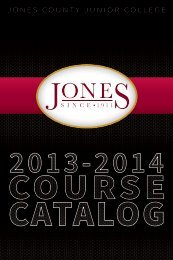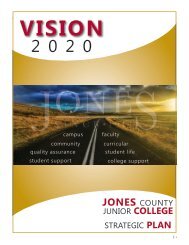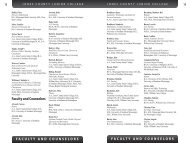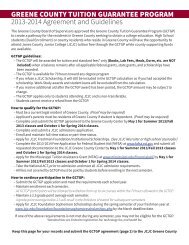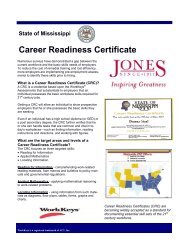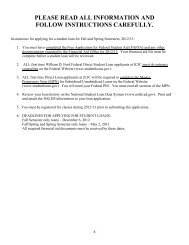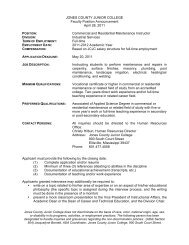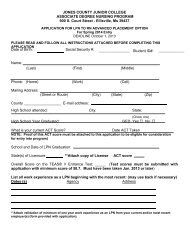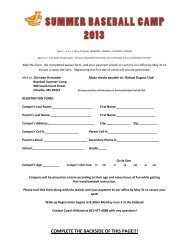SCRMC Patient Safety Module
SCRMC Patient Safety Module
SCRMC Patient Safety Module
You also want an ePaper? Increase the reach of your titles
YUMPU automatically turns print PDFs into web optimized ePapers that Google loves.
<strong>SCRMC</strong><br />
<strong>Patient</strong> <strong>Safety</strong> <strong>Module</strong><br />
1
<strong>SCRMC</strong> Nurse Educator extension 4929.<br />
* refers to nurse specific information<br />
<strong>SCRMC</strong> <strong>Patient</strong> <strong>Safety</strong> <strong>Module</strong><br />
*Anticoagulant <strong>Safety</strong> 26<br />
*Avoiding Wrong Site Surgery/Wrong Procedure 27<br />
*Critical Lab Values 22<br />
*Error Reporting 27<br />
*High Alert Medications “P-I-N-C-H” 24<br />
*Look Alike/Sound Alike (LASA) 25<br />
*Medication Reconciliation 25<br />
*Medication <strong>Safety</strong> 24<br />
*Verbal/Phone Orders 21<br />
Chain of Command 4<br />
Communication “S-H-A-R-E-D” 4-5<br />
Do Not Use Abbreviations 6<br />
Door Signs 6<br />
Equipment/Clinical Alarms 15<br />
Hospital Acquired Infections 9-13<br />
Hospital Acquired Injuries 16<br />
Introduction 3<br />
<strong>Patient</strong> Participation in Safe Care 19<br />
<strong>Patient</strong> Identifiers 6-7<br />
<strong>Patient</strong>s and Families Have a Voice About Care 19<br />
Post Fall Management 17<br />
Restraints 29-40<br />
Skin <strong>Safety</strong> 17-18<br />
Suicide Risk Assessment/Prevention 20<br />
Transmission-based Precautions 10-12<br />
2
INTRODUCTION<br />
Hospitals are complex facilities, made up of specialized, highly technical and<br />
interdependent processes. This complexity causes many factors that threaten the<br />
safety of patients. <strong>Safety</strong> threats occur when mistakes are made by people, but may<br />
also occur when everything is done correctly. It has been reported that as many as<br />
44,000 people die every year from medical mistakes. Some believe the best way to<br />
prevent patient injuries is to acknowledge that safety risks are inevitable. If safety<br />
risks to patients are inevitable, we must design ways to make it harder for nurses and<br />
other health care workers to do the wrong thing, and easier for them to do the right<br />
thing. Good communication and reliable documentation are key to identifying what<br />
the risks are and what preventive measures are needed.<br />
South Central Regional Medical Center is committed to providing a safe patient<br />
environment and conducts an interdisciplinary safety program coordinated by our<br />
<strong>Safety</strong> Committee. Nursing personnel must continuously monitor patients and<br />
recognize situations that place patient’s safety at risk. Any safety concerns should be<br />
reported immediately to the unit director who will follow up. Any incident or<br />
occurrence that is outside normal operations should be reported.<br />
The Joint Commission (accrediting agency) establishes National <strong>Patient</strong> <strong>Safety</strong> Goals<br />
annually. Addressed within these pages are <strong>SCRMC</strong>’s guidelines related to these<br />
safety goals and other items deemed relevant to patient safety. The emphasis on safety<br />
for our patients, visitors, and staff is of utmost importance. If you become aware of a<br />
safety issue that needs to be addressed, take action! If it is a spill on the floor and you<br />
are capable of wiping it up, do so. If it is an issue that needs other attention, report it<br />
to your Charge Nurse or Unit Director so the appropriate action may be taken. <strong>Safety</strong><br />
is the responsibility of EVERY employee and each is urged to do one’s part.<br />
3
Chain of Command<br />
As with any business, South Central has a chain of command in effect. Should an<br />
issue arise regarding patient safety, interpreting physician’s orders, assessment<br />
findings, diagnostic results, or other questions or concerns, one is admonished to<br />
follow the chain of command in resolving the problem. Each inpatient unit has a<br />
Charge Nurse readily available to the staff. The Unit Director or Clinical Nursing<br />
Coordinator is also available. Should a patient care issue not be resolved to the<br />
satisfaction of the staff nurse, Charge Nurse, or Clinical Coordinator, the Associate<br />
Executive Director of Nursing or the Administrative Executive on call may be<br />
contacted. Clinical, medical, and administrative personnel are available 24 hours a<br />
day, seven days a week as resources when needed.<br />
Communication<br />
<strong>Patient</strong> care is complex and involves multiple people. Because of this, good<br />
communication is critical to the patient’s safety and well-being. Errors in<br />
communication have been identified as the number one cause of medical errors<br />
that harm patients.<br />
“SHARED”<br />
<strong>SCRMC</strong> has adopted the “S-H-A-R-E-D” process to exchange patient information<br />
between one care giver and another. This allows for pertinent information to be<br />
exchanged and questions clarified between care givers. This process is used to “handoff”<br />
patient information in a variety of circumstances; i.e., shift-to-shift report, meal<br />
breaks, transfer between departments, and others. This information may be verbal or<br />
written, but it is critical to patient welfare that appropriate, pertinent information is<br />
“shared” by care givers.<br />
4
Below is a brief description of the “S-H-A-R-E-D” process:<br />
“S” - Situation or subject. What needs to be addressed? What is the purpose for<br />
the exchange of information?<br />
“H” - History. What information in the patient’s history is relevant to this<br />
communication?<br />
“A” - Assessment. What pertinent findings need to be exchanged? VS, lab<br />
results, complaints, signs and symptoms, other?<br />
“R” - oRders, results, requests. Were orders given to address the specific<br />
situation?<br />
“E” - Evaluate. Has the situation changed? Do other resources need to be<br />
informed?<br />
“D” - Document. What were the specifics of the information exchanged and the<br />
outcome of the communication?<br />
5
Do Not Use Abbreviations<br />
Communication is passed on through many<br />
ways, one of which is written. <strong>SCRMC</strong> has a<br />
list of “Do Not Use Abbreviations” in an<br />
attempt to minimize misinterpretations. These<br />
are not to be used by any employee that<br />
documents on the patient’s medical record. Do<br />
Not Use<br />
U or u (unit)<br />
IU (international unit)<br />
Q.D., QD, q.d. ,qd (daily)<br />
Q.O.D., QOD, q.o.d., qod (every other day<br />
Trailing zero (X.0 mg)<br />
Lack of leading zero (.X mg)<br />
MS, MSO4,<br />
MgSO4<br />
Additional Considerations Not to Use<br />
> (greater than); < (less than)<br />
Abbreviations for drug names<br />
@ (at)<br />
cc (cubic centimeter)<br />
µg (microgram)<br />
Use Instead<br />
Write “unit”<br />
Write “International unit”<br />
Write “daily”<br />
Write “every other day”<br />
Write “X mg”<br />
Write “0.X mg”<br />
Write “Morphine sulfate”<br />
Write “Magnesium sulfate”<br />
Use Instead<br />
Write “greater than” or “less than”<br />
Write drug names in full<br />
Write “at”<br />
Write “ml” or “milliliter”<br />
Write “mcg” or “microgram”<br />
Door Signs<br />
Another method of patient communication is door signs. Information such as<br />
NPO, Fall Risk, Stop - Check With Nurse Before Entering, and other signs<br />
are used to alert all that enter the patient’s room of general information. None<br />
of these signs violate the HIPAA regulations regarding confidentiality.<br />
<strong>Patient</strong> Identifiers<br />
The two patient identifiers of name and date of birth are used and can be<br />
found on the patient’s identification band. One may ask a patient’s name out<br />
of courtesy, but there is no substitute for checking the arm band for<br />
identification. <strong>Patient</strong> identification must be verified before administration of<br />
medications, specimen collection, blood administration, surgery, or any other<br />
6
specific intervention for that patient only. Even if the patients’ vital signs are<br />
checked, be sure it’s the correct patient - not just the patient in Room #X.<br />
Should there be a difference between the name and date of birth on the<br />
identification armband and the lab slip, meal tray card, medication<br />
administration record, or other piece of data - STOP! Do not proceed with the<br />
intervention until the discrepancy is resolved! Errors in lab results or<br />
medication administration can have life-threatening consequences. ALWAYS<br />
check for the correct patient identification!<br />
Each patient must have an identification armband on at all times. On<br />
admission, the presence of an armband is initially documented on the nursing<br />
admission papers, then it’s presence reassessed each shift and documented on<br />
the nursing daily flowsheet. Each care giver is responsible for educating<br />
patient and family on the importance of an armband being in place. Many<br />
patient care errors would have been avoided if the basic step of patient<br />
identification had not been omitted!<br />
Study Questions<br />
The number one cause of medical errors that harm patients is due to<br />
_____________________________________.<br />
The “S-H-A-R-E-D” process is used to exchange patient information<br />
between one care giver and another. Name situations when sharing of patient<br />
information should be implemented: _______________, _______________,<br />
_______________.<br />
True or False The shared information may be only in writing.<br />
<strong>SCRMC</strong> like all healthcare facilities has a list of “Do Not Use<br />
Abbreviations” in an attempt to minimize misinterpretations. These<br />
abbreviations are not to be used by any employee that documents on the<br />
patient’s medical record. Below is a list of “Do Not Use” Abbreviations.<br />
Insert the acceptable alternative for the Do No Use term.<br />
U or u __________<br />
IU _____________<br />
Q.D., QD, q.d. ,qd ___________<br />
7
Q.O.D., QOD, q.o.d., qod ____________<br />
Trailing zero (example 5.0 mg)___________<br />
Lack of leading zero (.5 mg) _____________<br />
MS, MSO4 ______________<br />
MgSO4 _____________________<br />
Additional Considerations Not to Use<br />
> (_________); < (___________)<br />
@ (____)<br />
cc (___________)<br />
µg (__________)<br />
______ ______ are used to communicate patient information such as NPO,<br />
Fall Risk, Stop - Check With Nurse Before Entering, and other signs are used<br />
to alert all that enter the patient’s room of general information.<br />
True or False Signs placed on the patient’s room door containing the above<br />
patient information are HIPAA compliant (Health Insurance Portability &<br />
Accountability Act- protected health information (PHI).<br />
The two patient identifiers used to identify the patient are: ______ & ______.<br />
This information can be found on the patient’s ______________. In addition<br />
to this information, you must ask the patient to verbally give you this<br />
information- name and DOB<br />
<strong>Patient</strong> identification must be verified when? (give as many examples as you can<br />
think of)_____________________________________________________________________<br />
____________________________________________________________________________<br />
_____________________________________________________________<br />
What should the nurse do if there is a discrepancy between the information on the<br />
patient’s identification armband and the lab slip or medication record? _______<br />
_____________________________________________<br />
The presence of the armband is reassessed each ______ and documented on<br />
the nursing daily flowsheet.<br />
Many patient care errors would have been avoided if the basic step of<br />
patient identification had not been omitted!<br />
8
Healthcare Associated Infections<br />
Healthcare associated infections are those that are attributed to being in the<br />
hospital. The greatest occurrence is usually a “staff” infection - one that is<br />
transmitted from health care worker or “staff” to patients. Many practices<br />
help prevent infections in a hospital; some of these are environmental<br />
cleanliness, proper hand hygiene, use of appropriate personal protective<br />
equipment (PPE), standard precautions, transmission-based isolation<br />
precautions, and use of sterile or aseptic technique. Adherence to these and<br />
other practices reduce and/or prevent the spread of disease and infection.<br />
Hand hygiene is the number one way to prevent the spread of infection<br />
by destroying microorganisms on the hands. Hands should be washed with<br />
soap and water for at least 15 seconds when visibly soiled. Alcohol-based<br />
hand cleaner is used when the hands are not visibly soiled, before and after<br />
gloves, before and after patient contact, and between patient encounters.<br />
<strong>SCRMC</strong>’s hand hygiene policy also addresses the length of nails, nail polish,<br />
and jewelry . Nails should not be visible above the fingertips when looking at<br />
the hand from the palm side; no nail polish or artificial nails are permitted;<br />
and jewelry is limited.<br />
Personal protective equipment (PPE) is used to protect the care giver from<br />
many forms of contamination. The most commonly used are gloves and<br />
masks. The PPE should be appropriate for the situation - no more or less than<br />
is needed. One has access to gloves, masks (with and without eye shield),<br />
gowns, and hand sanitizer. ( More will be discussed with transmission based<br />
precautions.) All PPE should be removed and discarded before exiting the<br />
patient’s room.<br />
Standard precautions are indicated and practiced on all patients as though<br />
they were infectious. Because the health care provided cannot determine if a<br />
patient has some illness or infection by looking at them, all patients are<br />
considered potentially infectious and require standard precautions be utilized.<br />
This includes the same PPE as discussed previously. Again, good hand<br />
hygiene is essential!<br />
9
Transmission-based precautions are aimed at containing and preventing the<br />
spread of infectious organisms from patient to staff to another patient. These<br />
precautions are frequently referred to as types of “isolation.” In order for<br />
transmission to occur, the organism from one infectious source enters a<br />
“host” (healthcare worker) and the “host” transmits the infection to another<br />
patient. Transmission may occur from direct contact with the patient or<br />
source of infection, i.e., wound, or from contact with an inanimate object in<br />
the patient’s room, i.e., siderail. Regardless of the source of infection, the<br />
chain of transmission MUST be broken for the welfare of patients and staff<br />
alike.<br />
<strong>SCRMC</strong> has 3 types of transmission-based precautions: Contact, Droplet,<br />
and Airborne. For each of these, a door sign would be used stating “STOP -<br />
check with nurse before entering the room.” This alerts all who enter if<br />
specific actions must be taken prior to entering. This does not violate HIPPA<br />
because no confidential information is given. If an employee from another<br />
department, visitor, or family member wishes to enter the patient’s isolation<br />
room, he/she will need the same protection as the nursing staff. The nurse<br />
will be responsible for educating those who enter on the safety precautions to<br />
use.<br />
Contact Precautions<br />
Contact precautions are taken when the patient has an infection that may<br />
spread by touching the patient or touching things in the patient’s room. This<br />
would include MRSA (Methicillin Resistant Staph Aureus) in a wound, VRE<br />
(Vancomycin Resistant Enterococci) in urine or stool, HIV (Human<br />
Immunodificiency Virus) in blood or body fluids, or some other GI, GU, or<br />
skin infections. Gloves should always be worn as well as a gown if<br />
splattering or contamination is possible. Equipment for this isolated patient<br />
should be restricted to this patient only when possible. Central Supply will<br />
provide a stethoscope, blood pressure cuff, thermometer, and IV pump for<br />
this patient. Any other equipment that enters the patient’s room must be<br />
wiped down with an antimicrobial wipe and allowed to dry before being used<br />
on another patient, i.e., Accucheck monitor. After discharge, the reusable<br />
equipment is wiped down to remove gross contaminants then taken to Central<br />
10
Supply for disinfecting before other patient use. Disposable items are “redbagged”<br />
if contaminated.<br />
Droplet Precautions<br />
Droplet precautions are implemented when the patient’s infection is in the<br />
airway and therefore transmitted by moisture droplets from the upper<br />
respiratory system. When the patient speaks, coughs, sneezes, and sometimes<br />
just breathes, the infectious organism is propelled from the upper respiratory<br />
tract by way of the moisture droplets. Gravity causes these droplets to fall on<br />
surfaces usually within 5 - 8 feet. This may be MRSA in the sputum, TB, or<br />
other respiratory or oral/nasal infections. In addition to gloves, the person<br />
entering the room should wear a mask with protective eye shield. Gowns may<br />
be worn if contamination of clothing is expected as with a patient with a<br />
tracheostomy.<br />
If a patient has TB, he/she will be placed in a negative-pressure room that<br />
pulls the air into the outside atmosphere. This decreases the concentration of<br />
the organisms and exposes the organisms to ultraviolet light. These rooms<br />
MUST have the door to the hallway closed for the negative-pressure to be<br />
activated. Emergency Department, Critical Care Unit, and 3 West have such<br />
rooms. These patients must wear a mask when transported from one<br />
department to another and the staff of the receiving department must use the<br />
same protective measures while the patient is in their care.<br />
Airborne precautions<br />
Airborne precautions are indicated when patients have infectious organisms<br />
transmitted from the respiratory tract into the air, i.e., TB. The contaminated<br />
organism can travel great distances on dust or other microscopic particles in<br />
the air. These contaminated particles may infect someone not in close<br />
proximity to the patient. Gloves and masks are necessary to use; eye shield<br />
may be necessary if potential contamination may occur. The masks (N95)<br />
worn are to be airtight to prevent any airborne particles from being inhaled.<br />
These patients will be placed in a negative-pressure room as mentioned<br />
above.<br />
Reverse isolation may be implemented for patients who are<br />
11
Immune suppressed or otherwise predisposed to infections. These patients are<br />
protected from others who might introduce an infection to them. They are<br />
placed in a well-ventilated room and strict hand hygiene should be used when<br />
providing care to these patients. Masks are worn to protect the patient from<br />
the health care provider’s respiratory droplets.<br />
If any patient is transported from an isolation area to another area of the<br />
hospital, inform the receiving department of the protective steps needed while<br />
the patient is in their care. The patient may need to wear a mask during<br />
transport if droplet or airborne precautions are in effect.<br />
Two of the more common healthcare associated infections nationwide are<br />
UTI’s (urinary tract infections) and pneumonia. Most UTI’s occur in<br />
patient’s with a foley or indwelling catheter. The best preventive action is to<br />
discontinue the catheter as soon as possible. In addition to strict aseptic<br />
technique during insertion, other measures that may decrease or prevent a<br />
hospital-acquired UTI are as follows:<br />
- using strict hand hygiene when touching any part of the catheter,<br />
- stabilizing the catheter to prevent movement in and out of the urethra,<br />
- positioning the tubing along the length of the bed to prevent<br />
dependent loops,<br />
- positioning the drainage bag at the foot of the bed,<br />
- maintaining a closed system,<br />
- preventing the exit portal of the bag from touching the floor, and<br />
- providing catheter insertion site care at least twice a day and PRN<br />
Healthcare associated UTI’s cost extra money for treatment as well as<br />
extra patient care days. Proper insertion and maintenance is essential to<br />
reducing this infection.<br />
Another frequently occurring healthcare associated infection is pneumonia.<br />
Many of our patients are elderly and any cause for immobility increases the<br />
risk of acquiring pneumonia. <strong>Patient</strong>s should be turned frequently,<br />
encouraged to cough and deep breathe, and become as active as possible as<br />
soon as possible. Care in feeding should be taken to avoid aspiration. Head<br />
12
of the bed should be elevated 30°or higher if appropriate for the patient.<br />
Good oral hygiene not only improves the patient’s sense of well-being but<br />
also decreases the microorganisms in the mouth. Ongoing assessments are<br />
necessary to detect cough, rhonchi, fever, sputum production and other<br />
potential symptoms of pneumonia. Again, strict hand hygiene plays an<br />
important role in decreasing transmission of organisms from one to another.<br />
Study Questions<br />
FILL IN THE BLANKS BELOW<br />
The number one way to prevent the spread of infection is good _______<br />
_______.<br />
3 types of transmission-based precautions are:________, ________, and<br />
_____________.<br />
________ precautions are taken when the patient has an infection that may<br />
spread by touching the patient or touching things in the patient’s room.<br />
__________ should always be worn as well as a _______if splattering or<br />
contamination is possible.<br />
__________ precautions are implemented when the patient’s infection is in<br />
the airway and therefore transmitted by moisture droplets from the upper<br />
respiratory system. When the patient speaks, coughs, sneezes, and sometimes<br />
just breathes, the infectious organism is propelled from the upper respiratory<br />
tract by way of the moisture droplets. In addition to _________ , the person<br />
entering the room should wear a _______ _______may be worn if<br />
contamination of clothing is expected.<br />
______ precautions are indicated when patients have infectious organisms<br />
transmitted from the respiratory tract into the air, i.e., TB. The contaminated<br />
organism can travel great distances on dust or other microscopic particles in<br />
the air. _______ and ______ are necessary to use; eye shield may be<br />
necessary if potential contamination may occur. A special mask is required,<br />
the mask is called a _______.<br />
__________ _______ may be implemented for patients who are<br />
13
immunosuppressed or otherwise predisposed to infections. These patients are<br />
protected from others who might introduce an infection to them.<br />
Two of the more common healthcare associated infections nationwide are:<br />
___________________ AND ____________.<br />
S_____ H________ H________ plays an important role in decreasing<br />
transmission of organisms from one to another.<br />
14
Equipment/Clinical Alarms<br />
As with any hospital, South Central has a multitude of equipment used<br />
directly or indirectly in patient care. Each manufacturer has built-in alarm<br />
systems to alert the user to possible problems. Our own Bio-Med department<br />
routinely checks each piece of equipment for proper functioning, preventive<br />
maintenance, and testing of the clinical alarm systems. Alarm systems may<br />
activate to alert the staff and patients of potential safety risks. Many pieces of<br />
equipment have a “silence button” to stop the audible sound of the alarm for<br />
a few seconds, but NO alarm should be turned off completely. The sound of<br />
the alarms should be loud enough to be heard over the routine noise of the<br />
day.<br />
Nurses are responsible for assuring that clinical alarms are activated on<br />
equipment in use and that the sound is sufficiently audible with respect to<br />
distance and competing noises on the unit. Some alarms reset automatically,<br />
but a frequently occurring alarm demands attention. With multiple pieces of<br />
equipment in use at the same time, the nurse cannot become desensitized to<br />
the sounds and take them for granted. Serious harm can be caused by<br />
malfunctioning equipment - each alarm deserves a thorough check to<br />
determine the problem and potential risk. If the equipment malfunctions, it<br />
should be removed from patient use after like equipment is replaced. Tag the<br />
equipment as “Defective” and notify the Bio-Med department.<br />
Alarm systems alert the staff and patients of _______ ________ ________.<br />
True or False If an alarm is annoying the patient and his family, it is okay to<br />
turn it off.<br />
A frequently occurring alarm demands _________<br />
If equipment is defective, what should the nurse do?___________________<br />
___________________________________________________________.<br />
True or False NO alarm should be turned off completely.<br />
15
Hospital-acquired Injuries<br />
Hospitals desire a safe place in which patient care is delivered, as well as a<br />
safe environment in which staff may work. Falls head the list for hospitalacquired<br />
injuries for patients and staff. This has led to a comprehensive fall<br />
prevention policy at <strong>SCRMC</strong>.<br />
All hospitalized patients will be assessed for risk of falling at the time of<br />
admission and reassessed every 24 hours. Fall risk will be determined using a<br />
modified Morse Fall Risk Assessment Scale and a low, moderate, or high<br />
category will be determined by the score obtained. > 40 indicates a “HIGH”<br />
fall risk.<br />
Preventive measures will be initiated on all patients as follows:<br />
Low risk (score 0 - 20)<br />
- 3 of 4 bed rails should be raised<br />
- personal items within easy reach<br />
- non-skid foot wear to be worn when up<br />
Moderate risk (score 21 - 39)<br />
- all low risk measures as above<br />
- instruct patient to call for assistance - “Call before you fall.”<br />
- address toileting needs before bedtime<br />
- round on these patients at least every 4 hours<br />
- do not leave this patient unattended in the bathroom<br />
High risk (score >40)<br />
- all low and moderate risk measures above<br />
- pharmacy referral for fall risk medication review<br />
- round on these patients at least every 2 hours; document on the<br />
toileting schedule when rounds were made and the person’s initials<br />
- have a planned toileting schedule<br />
- supervise when toileting, ambulating, and transferring<br />
- encourage families to stay with high fall risk patient<br />
- place visual of falling star inside front of chart cover and inside the<br />
patient’s room on the bulletin board or at the head of the bed<br />
- communicate from one care giver to another during hand-off<br />
reporting<br />
16
Post Fall Management<br />
The first priority after a patient fall is to assess the patient for any obvious<br />
injuries. Observe the skin for any breaks or abrasions, look for abnormal<br />
bone or joint alignment, and observe for restrictions in mobility. Intracranial<br />
injury should be considered for patients who are taking anticoagulants and hit<br />
their head during the fall. Hip fracture may be considered if the patient’s leg<br />
is misaligned and their foot is externally rotated. A blood sugar may be<br />
checked on diabetic patients who fall. Seek assistance if needed and use<br />
lifting equipment to get the patient off the floor. The patient should be<br />
observed closely following a fall; vital signs and neuro checks may be<br />
obtained as needed. (Refer to policy/procedure # 28.4)<br />
The number one hospital acquired injury to a patient is from a ________.<br />
The First priority after a patient fall is to assess_____________________<br />
____________________________.<br />
A fall score of 40 or more indicates a ________ ________ for a fall.<br />
“Risk for Fall” is assessed on each patient initially during _______and then<br />
every ___ hours thereafter.<br />
Skin <strong>Safety</strong><br />
Nationally 14% of all patients hospitalized have skin breakdown. Half come<br />
to the hospital with breakdown; the other half develops breakdown while in<br />
the hospital. The cost of care and the length of stay for patients with<br />
decubitus is greater than that for patients without decubitus ulcers. Many of<br />
our patients have risk factors that contribute to problems with skin integrity,<br />
such as poor nutrition, dehydration, incontinence, and immobility.<br />
All patients should have a thorough head-to-toe skin assessment on<br />
17
admission. The “Braden Scale”, a nationally recognized assessment tool, is<br />
used to predict the risk of developing impaired skin integrity. Risk categories<br />
of sensory perception, moisture, activity, mobility, nutrition, and friction and<br />
shear are reviewed and a numerical ranking is given to each area. If the score<br />
is >17, no action is needed. If, however, the score is 15 - 16, the patient is at<br />
mild risk for potential skin breakdown and the Skin Care Standard #32<br />
should be initiated. A score of < 14 indicates moderate to severe risk and a<br />
referral to the Wound-Ostomy-Continence-Nurse (WOCN) is made. For<br />
some patients, even the best of care may not prevent impaired skin integrity,<br />
but preventive measures must be implemented and followed in an effort to<br />
prevent this safety risk.<br />
Skin tears are another form of skin impairment that deserves careful<br />
attention. Many of the elderly and chronically ill have very thin, frail skin<br />
that is easily damaged. Obtain help from another member of the nursing team<br />
to assist in turning, transferring, and toileting these patients. Even the<br />
slightest touch on these patients’ skin can result in a tear, which is considered<br />
a hospital acquired injury. WOCN consult can help both in treatment but<br />
especially in prevention of these types of skin impairments.<br />
The “_______ Scale”, a nationally recognized assessment tool, is used to<br />
predict the risk of developing impaired skin integrity.<br />
18
<strong>Patient</strong> Participation In Safe Care: “Nothing about me<br />
without me!”<br />
At <strong>SCRMC</strong>, we encourage patient and family participation in their care; this<br />
includes keeping them informed and answering their questions. <strong>Patient</strong> and<br />
family education should be integrated into your care. As patients and families<br />
become more aware and educated on their healthcare needs, the potential<br />
grows for increased compliance. Interdisciplinary team members contribute<br />
to the patient’s and family’s understanding of the many facets of their<br />
individual care; some of these are Diabetic Education, Dieticians, Wound and<br />
Ostomy Nurses, and Social Services. Remember, “Nothing about me without<br />
me” means to keep the patient and family informed and involved in their<br />
treatment decisions.<br />
<strong>Patient</strong>s and Families Have a Voice About Concerns In Care<br />
At times, patients and families may feel their concerns about the care or<br />
condition of their loved one are not being adequately addressed. <strong>Patient</strong>s and<br />
families are encouraged to express their concerns to the staff rendering the<br />
care. If concerns are not addressed satisfactorily, the situation is referred<br />
through the hospital chain of command for a rapid response and resolution.<br />
As with any concern within the hospital, the Chain of Command is in effect<br />
with the medical staff and the hospital in general.<br />
The nursing Clinical Coordinator is available 24 / 7 to review the patient’s<br />
current condition and areas of concern. The Coordinator then may address the<br />
situation personally or refer to other disciplines as needed to resolve the issue<br />
at hand.<br />
19
Suicide Risk Assessment/Prevention<br />
The Emergency Department and inpatient nursing units assess each patient<br />
for suicide risk factors. If a patient has made a suicide attempt, has thoughts<br />
of suicide, or a suspected psychiatric diagnosis, a SAD PERSONS scale is<br />
completed on these individuals. The SAD PERSONS scale allows the care<br />
giver to arrive at a numerical ranking of the patient’s suicide risks factors<br />
along with recommended guidelines for interventions.<br />
The nurse on the inpatient units enters the fact that the SAD PERSONS scale<br />
was done and the patient’s score on the Interdisciplinary Care Plan for the Dr.<br />
to review. The scale is filed under the Interdisciplinary Progress Notes in the<br />
paper chart along with the nursing admission papers. After review by the<br />
physician, further treatment/interventions may be ordered.<br />
The SAD PERSONS<br />
scale consists of the<br />
following categories:<br />
Risk Factor<br />
Sex (gender)<br />
Age<br />
Depression<br />
Prior attempts<br />
ETOH<br />
Rational thought (loss of) or<br />
Psychosis<br />
Support/Lack of<br />
Organized plan<br />
No spouse<br />
Sickness<br />
Low Risk<br />
Female<br />
20 - 45 years<br />
Mood is NOT<br />
significantly<br />
depressed<br />
No prior<br />
attempts<br />
Not ETOH or<br />
drug dependent<br />
No psychotic<br />
symptoms<br />
Has emotional<br />
&/or social<br />
support<br />
Simple ideation<br />
or impulses<br />
Family support<br />
or significant<br />
other is available<br />
No medical<br />
problems<br />
causing stress<br />
0 High Risk<br />
Male<br />
< 19 or > 45<br />
Mood IS<br />
significantly<br />
depressed<br />
1or more prior<br />
attempts<br />
Is ETOH or drug<br />
dependent<br />
Psychotic<br />
symptoms<br />
No significant<br />
emotional or<br />
social support<br />
Articulates an<br />
organized plan<br />
No spouse or<br />
significant other<br />
Medical<br />
problems not<br />
well controlled<br />
& source of<br />
stress<br />
Recommended guidelines for interventions based on points given:<br />
0 - 2 Outpatient follow up; assist with appointment<br />
3 - 4 Supervised, supported outpatient follow-up; hospitalization for some pts<br />
5 - 6 Hospitalization unless safe alternative arranged and verified; psychiatrist consult16<br />
7 - 10 Hospitalization; may need involuntary commitment; psychiatrist consult<br />
1<br />
20
The SAD PERSONS scale allows the care giver to arrive at a numerical<br />
ranking of the patient’s _______ _______ factors along with recommended<br />
guidelines for interventions.<br />
*NURSE SPECIFIC<br />
In addition to the above general safety information, nurses are responsible for the<br />
following as well.<br />
Verbal/phone orders<br />
Verbal orders are discouraged because it creates an opportunity for an addition or<br />
deletion from what was said. If , however, a verbal or phone order is taken, the<br />
nurse (or other listed below) is to “read back” the information obtained to verify<br />
and clarify the information given. Verbal orders may be taken by the following<br />
disciplines according to their scope of practice and by <strong>SCRMC</strong>’s medical staff<br />
bylaws:<br />
- Registered Nurses<br />
- Licensed Practical Nurses<br />
- Pharmacists<br />
- Physical Therapists & Speech/Occupational Therapists<br />
- Registered Dietitians<br />
- Registered Respiratory Therapists<br />
- Licensed Radiologic Technicians<br />
- Emergency Medical Technicians/Paramedics<br />
- Certified Registered Nurse Anesthetists<br />
Only a physician or his/her designee may give verbal orders; only those<br />
credentialed by the medical staff may give orders for medications. The verbal order<br />
is to be recorded in the patient’s medical record immediately and signed by the<br />
prescribing physician within 24 hours.<br />
True or False All phone or verbal orders must be “read back” to clarify the<br />
information given.<br />
Registered Nurses, Licensed Practical Nurses, Pharmacists, Physical and<br />
Occupational and Speech Therapist, Licensed Radiology Techs and EMT and<br />
paramedics and Nurse Anesthetists can take verbal orders because _________<br />
_____________________________________________________________<br />
21
Critical Lab Values<br />
As with verbal orders, verbal or phone lab values should be “read back” as<br />
well - especially critical lab values. Critical lab values are defined by<br />
laboratory standards and a list of critical values at <strong>SCRMC</strong> are found in the<br />
lab manual. When a critical lab value occurs, the lab will call the appropriate<br />
patient care area to alert the staff that a critical value has been identified.<br />
Usually the lab does not report the value over the phone but alerts the staff to<br />
be on the look-out for the critical results to be reported by fax from the lab or<br />
resulted under the flowsheet tab in Cerner, the electronic medical record.<br />
After the nurse receives the critical lab value, a physician involved it the<br />
patient’s care must be notified within one (1) hour. Before physician<br />
notification, be sure no other labs have critical values on the same patient -<br />
ask the lab regarding other tests being done in a different lab department; i.e.,<br />
CBC, BMP, etc. Check the patient’s medical record for previous lab results<br />
(the previous result could have been critical also but this one may show<br />
improvement). The nurse must notify a physician of the critical lab values<br />
within one hour unless there is a written order on the chart not to do so.<br />
Ten laboratory results will populate to the eMAR or CareMobile in Cerner to<br />
alert the nurse of these specific findings:<br />
Hematocrit<br />
Hct<br />
Hemoglobin<br />
Hgb<br />
White Blood Cell<br />
WBC<br />
Partial pressure of CO 2<br />
pCO2<br />
Glucose<br />
Glu<br />
Potassium<br />
K<br />
International normalized ratio INR<br />
Vancomycin trough<br />
Troponin I<br />
Creatinine<br />
Cr<br />
These plus other lab findings will be resulted in the computer and may be<br />
found under the “Flowsheet” tab in Cerner for that specific patient. Abnormal<br />
results are recorded in red with either an “H” (high), “L” (low), or “C”<br />
(critical) noted beside the result. Normal results are recorded in blue.<br />
22
Questions<br />
After the nurse receives a critical lab value, a physician involved it the<br />
patient’s care must be notified within _____ hour.<br />
Before the nurse initiates the notification of critical lab, the nurse must<br />
check_________________________________________________________<br />
______________________________________________________________<br />
23
Medication <strong>Safety</strong><br />
Safe and accurate medication administration is an ongoing goal at <strong>SCRMC</strong>.<br />
Multiple steps have been taken to ensure maximum safety in this regard.<br />
Again, as a reminder, the 2 patient identifiers are name and date of birth;<br />
both of which are found on the patient’s identification bracelet. Many<br />
medication variances could have been prevented if healthcare providers had<br />
adhered to this basic step. The “five rights” (patient, medicine, dose, route,<br />
and time) of medication administration are enhanced by the use of electronic<br />
documentation of medicines through Cerner using the eMAR or CareMobile.<br />
These checks are done at the point of care - at the patient’s bedside; thereby<br />
decreasing the inadvertent occurrence of a medication variance.<br />
Question<br />
Where does the nurse perform Point of Care <strong>Safety</strong> Checks?______________<br />
High Alert Medications<br />
The acronym “P-I-N-C-H” has been adopted to remind the nurses of<br />
<strong>SCRMC</strong>’s high alert medications. These are meds with a narrow margin of<br />
safety and a heightened occurrence of potential harm if not administered<br />
carefully. Each of these meds require a “nurse witness”; that is, a second<br />
nurse must review and document the dosage needed before administered to a<br />
patient. The following explains the acronym and situations when a nurse<br />
witness is required:<br />
“P” - potassium or other concentrated electrolytes when given in an IV to a<br />
patient < 13 years or > 80 years of age<br />
“I” - insulin with each dose, whether IV or subcutaneously<br />
“N” - narcotics when given to a patient < 13 years or > 80 years of age; all<br />
neuromuscular blocking agents (paralytics)<br />
“C” -chemotherapy when given parenterally<br />
“H” - heparin with each dose whether IV or subcutaneously<br />
24
IV infusion pumps are used on all IV admixtures (except for multivitamins or<br />
MVI), especially on all high alert meds. Any dosage calculations should be<br />
checked and verified by another nurse or pharmacist when needed. If a verbal<br />
or phone order was given, “read back” the order for verification. Note the<br />
alert labels placed by Pharmacy on medications when the order is such that<br />
the standard concentration is not used.<br />
Match the Pinch Drugs<br />
__Concentrated Electrolyte solution<br />
__Diabetes medication<br />
__Blood Thinning Agent<br />
__Cancer Drug<br />
__Pain Medication<br />
A. Insulin<br />
B. Potassium (young & old patients<br />
C. Chemotherapy<br />
D. Heparin<br />
E. Narcotic (young & old patients)<br />
PINCH drugs require a nurse ________________<br />
Look alike/Sound alike Medications (LASA)<br />
With an increase of medication development comes the increase of<br />
potentially confusing names. A list is maintained by Pharmacy of lookalike/sound-alike<br />
meds and these meds are “stickered” with a precaution<br />
when dispensed from the Pharmacy. This sticker alerts the nurse to double<br />
check to be certain the med being given is the one desired.<br />
Two frequently administered medicines that look-alike/sound-alike are<br />
Heparin and Insulin preparations. All Insulins are kept in compartmentalized<br />
containers in the medication refrigerator with each specific type kept separate<br />
from the others. Heparin dosages are labeled with the sticker to call attention<br />
to the strength of the medicine. There is NO SHORTCUT for checking the<br />
label of the med when you pick it up, when you draw it up, and before<br />
you administer it! Don’t ever forget the basics!<br />
Medication Reconciliation<br />
Medication reconciliation helps prevent patient harm from medicines.<br />
Medication reconciliation is the means by which the patient’s medications<br />
25
and how taken at home are verified and made available for the physician to<br />
continue, modify, or discontinue while in the hospital.<br />
When a patient is transferred from one level of care to another (CCU to<br />
nursing unit or Surgery to nursing unit), their medicines are reconciled. At<br />
the time of discharge, a complete list of all the patient’s medicines to be<br />
continued is generated for the patient’s information or that of the next health<br />
care provider. This insures safe and accurate medication instruction before,<br />
during, and after the patient’s stay.<br />
Upon presentation to the hospital, the patient or his/her representative is<br />
asked about current medications being taken. If bottles or a list are provided,<br />
the staff carefully questions the patient regarding how the medicines are<br />
actually taken in comparison to the directions on the bottle or list. A “Home<br />
Medication List” is recorded as the patient takes the meds for the physician<br />
to review including the medicine, dosage, route, frequency, and purpose.<br />
After the review of this “Home Med List”, the physician indicates the meds<br />
to be continued or discontinued by checking the appropriate blank beside the<br />
medication. Once dated, timed, and signed, the sheet is prepared for faxing to<br />
the pharmacy.<br />
Anticoagulant <strong>Safety</strong><br />
Multiple steps are taken to ensure safe anticoagulant therapy. Heparin is one<br />
of the “PINCH” or high alert meds that requires a nurse witness before the<br />
dose is given. The INR is one of the lab results that populates to the eMAR<br />
alerting the nurse to this result. Reducing the likelihood of patient harm<br />
associated with the use of anticoagulant therapy requires an interdisciplinary<br />
approach. The nurse should always check the anticoagulant therapy order<br />
closely noting the dose, route, frequency and the appropriateness for the<br />
26
patient’s clinical situation. The Heparin protocol outlines the standards of<br />
care for Heparin therapy.<br />
High alert medications are meds with a _______margin of safety and a<br />
heightened occurrence of potential _______ if not administered carefully.<br />
Avoiding Wrong Site Surgery/Wrong Procedure<br />
Normally before any invasive procedure/surgery can be performed, the<br />
patient or another acting on the patient’s behalf must give consent. The<br />
physician provides “informed” consent regarding the specifics of the<br />
procedure and a licensed person witnesses the signing of the consent. At<br />
times, telephone consent is obtained, necessitating that two licensed persons<br />
must verify the consent and both witness the consent form. This begins the<br />
process of correct patient, procedure, and site.<br />
If laterality is involved, the site will be marked with an indelible, latex-free<br />
marker. The patient is encouraged to participate in this verification process<br />
by stating “which part” and “what” is going to be done. Only if the<br />
practitioner, who is performing the procedure, is in continuous attendance<br />
with the patient from the time the decision is made to do the procedure and<br />
consent is obtained, until the procedure is completed, can the site marking be<br />
exempted.<br />
A “time-out” is performed just prior to the procedure as a final verification of<br />
the correct patient, procedure, and site. This process is also used when<br />
procedures are done at the patient’s bedside; i.e., chest tube or PICC line<br />
insertion. Any discrepancy identified will result in an immediate halt to the<br />
procedure until the discrepancy can be resolved. A “Reportable Event” form<br />
should be used to report the discrepancy.<br />
Question<br />
Final verification of right patient, procedure and site is completed<br />
when?_______________. The name of this verification process is<br />
_____________________________.<br />
Error Reporting<br />
At times, events develop outside the expected. Any variance from normal<br />
operations which may result in an actual or potential risk to patients, visitors,<br />
27
or staff should be reported by completing a “Reportable Event” form. This<br />
will be reviewed by your director and then sent to Administration. Employee<br />
injuries should be reported on an “Employee Occurrence Report” and sent<br />
to Employee Health. Any variance related to medications should be reported<br />
on the “Error Hotline” at 4227 or on a “Medication Variance Report.”<br />
Nurses may be responsible for reporting Sentinel Events. A sentinel event is<br />
an unexpected occurrence involving death or serious physical or<br />
psychological injury, or the risk thereof. Serious injury specifically includes<br />
loss of limb or function. The phrase “or risk thereof” includes any process<br />
variation for which a recurrence would carry a significant chance of a serious<br />
adverse outcome. Types of sentinel events may include but are not limited to:<br />
any patient death, coma, medication error, suicide, patient elopement,<br />
procedure performed on wrong patient or wrong site, any assault, falls, and<br />
hemolytic transfusion reactions. Report “near misses” that could have<br />
resulted in any of these outcomes. Report these events immediately to your<br />
director or supervisor. Your most important action following a reportable<br />
event or medication variance is to assess your patient and respond to their<br />
needs. A report should be filled out with documentation of the situation. A<br />
complete investigation of the incident will include ways to prevent the error<br />
from recurring.<br />
Question<br />
A reportable event covers the following situations _____________________<br />
______________________________________________________________<br />
A sentinel event is _______________________________________________<br />
______________________________________________________________<br />
The nurse’s most important action following a reportable event or medication<br />
variance is to ________________________________________________.<br />
28
RESTRAINTS<br />
29
The table below shows the practice differences<br />
between medical-surgical restraints and those used<br />
for behavior control.<br />
Requirement Medical-Surgical Restraint Behavior Control Restraint<br />
Physician’s Order<br />
Order must include<br />
Time Limitation<br />
Initiation<br />
Requires a physician’s order<br />
which must be obtained within<br />
12 hours of application<br />
Purpose of the restraint, time limit, type<br />
of restraint, and clinical indications.<br />
Medical-surgical healing restraints are<br />
limited to 24 hours without a physician<br />
re-ordering the restraint<br />
Medical-surgical restraints may be<br />
initiated by a RN based on patient<br />
assessment<br />
Physician Notification The physician must be notified within 12<br />
hours of the initiation and a verbal or<br />
written order is obtained. If the<br />
restraints are based on a significant<br />
change in the patient’s condition, the<br />
physician is immediately notified.<br />
Physician Assessment<br />
Monitoring of the <strong>Patient</strong> by<br />
Nurses<br />
Documentation<br />
The patient must be evaluated by a<br />
physician within 24 hours<br />
These patients are observed by the<br />
nurse every 2 hours<br />
Monitoring is documented every 2 hours<br />
in the medical record<br />
Requires a physician’s order<br />
which must be obtained within<br />
one hour of application<br />
Purpose of the restraint, time<br />
limit, type, and clinical<br />
indications<br />
Behavior -control restraints<br />
are limited to 4 hours. After 4<br />
hours the restraints must be<br />
removed or re-ordered<br />
Only trained clinical staff may<br />
initiate behavior-control<br />
restraints<br />
The physician is notified as<br />
soon as possible but no longer<br />
than one hour after the<br />
initiation of the restraint.<br />
The physician must do a faceto-face<br />
evaluation of the<br />
patient within one hour<br />
Must be continuously<br />
monitored by one-on-one<br />
observation<br />
Monitoring is documented<br />
every 15 minutes<br />
40



